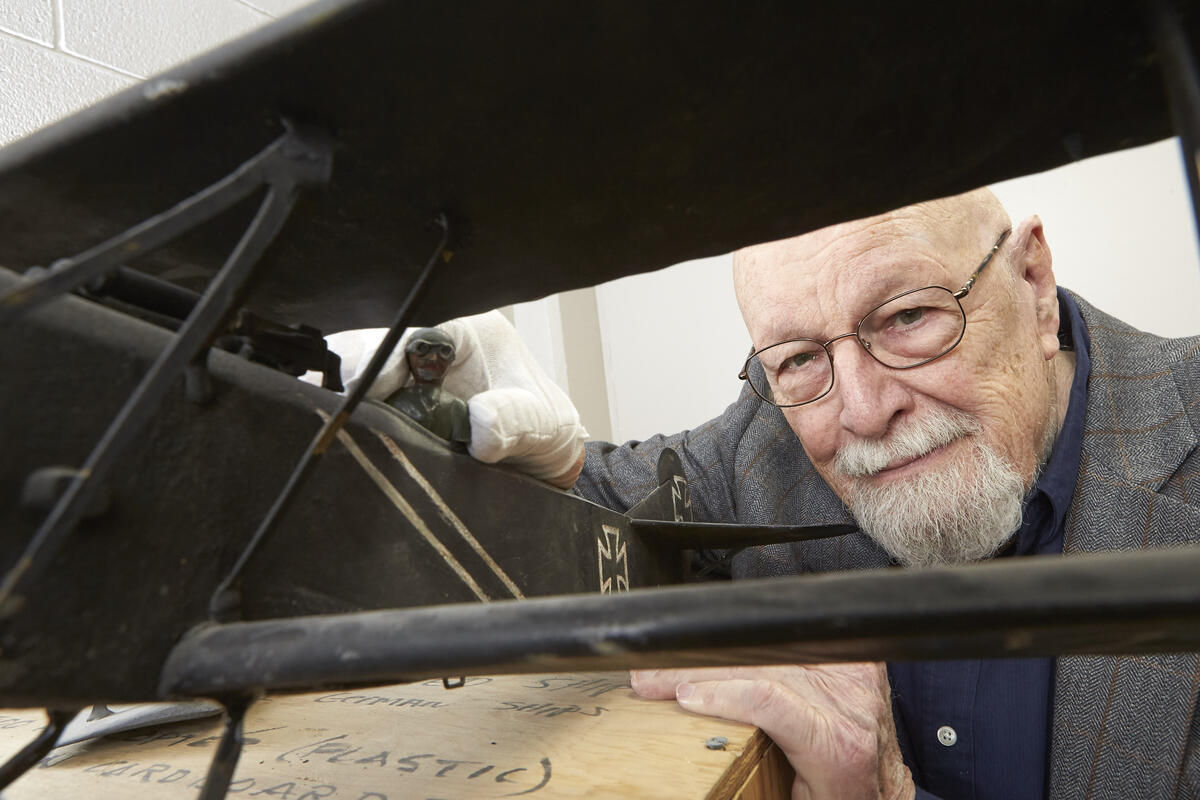The classic silent The Passion of Joan of Arc was released in 1928, and, thanks to a 1929 fire, everyone thought the original cut of Carl Theodore Dreyer’s masterpiece was lost. Until a full print of it was found in the janitor’s closet of a Norwegian mental institution.
You never know what’s going to turn up. Like, say, in a locked room on the bottom floor of the Flora Dungan Humanities building where, just sitting on a shelf are models of German and American biplanes that were used in the 1930 Howard Hughes film Hell’s Angels.
Hughes, ever the obsessive, saved everything from his film production companies, including The Caddo Co., his film studio of the 1920s and 30s. When it came time for the first-ever Academy Awards for Best Picture, Hughes and Caddo were one of three nominees, for 1928’s The Racket. Caddo would score another nomination in 1931 for The Front Page.
As the first and fourth Academy Awards give way to the 89th this weekend, Hughes’ legacy has never been more vibrant at UNLV.
After Hughes died in 1976, he left a vast collection of materials related to all his businesses — film, aviation, oil, tools and others — in warehouses at the Hughes Center. The Academy wanted to collect everything related to Caddo, but professor emeritus Hart Wegner, then head of the department of film, had other ideas. He argued that because of Hughes’ massive impact on Las Vegas, the parts of the collection related to film belonged here.
“At the presentation I made, I said it would mean something to us, not just Las Vegas, but to the university, and specifically to the department of film,” Wegner said. “To the Academy it would be another 800 boxes. To us, it would be a focal point of development.”

So from 1994 to 1996, materials in the collection — shot sheets, scripts, promotional materials, models, memos and everything in-between — were sent to UNLV for storage, where they’re currently available for study by scholars, like British silent film historian Kevin Brownlow, who came over to examine materials related to The Racket, Two Arabian Knights, and The Mating Call.
Before Martin Scorsese’s 2004 Hughes biopic The Aviator debuted, Christopher Nolan was working on a Hughes film of his own. He sought out the collection and spent a day here studying before eventually abandoning the project after Scorsese beat him to the punch.
While the actual films elements are stored by the Academy, the Hughes collection offers an unprecedented look at the inner workings of a silent film studio. Beyond even that, it offers a glimpse into the evolution of Hollywood and the effect it had on American culture in that era.
“What's exciting about this collection is it's not just about Hughes and some of his obsessions or monomaniacal tendencies, but this really huge chunk of Hollywood history from the 1920s to the 1970s — and we've got all of these materials,” said Heather Addison, chair of film. “Some of his employees were quite careful in the press clippings they collected. Just volumes and volumes of things related to what was going on with Hughes, his productions, his stars. He's intimately tied up in the development or evolution of Hollywood as an individual. Our mission is to preserve this.”
Some of the stories are telling. Addison’s first paper produced from the archives was related to Louis Wolheim, star of The Racket and a Caddo contract player. Thanks to several injuries, Wolheim had a crooked nose and a jutting chin. It earned him roles as underworld heavies, but he wanted the accolades of a romantic lead. So he sought out plastic surgery.

“Wolheim announces he's going to have this surgery done, and there's this tsunami of press coverage,” Addison said. “There are volumes of clippings from newspapers all around the country. People were pro surgery, and people who were against, for various reasons.”
The production company filed an injunction to stop Wolheim from getting the surgery. It worked — or at least that’s what the press reported at the time. There’s still speculation that the whole thing was a publicity stunt, but it still reveals, Addison said, just what plastic surgery meant to the physical culture at the time, with which Hollywood was inextricably intertwined.
“It kind of gives us the sense of the gendered practice of plastic surgery in the 1920s already,” Addison said. “It was all right for women, but for a man to get beautified, people were horrified at the idea of this.”
There’s still a long road to go before the collection is completely accessible. Everything is on acid paper, and time is the enemy. Pages have to be taken out of filing cabinets and specialdouble-locking storage boxes that Hughes designed himself. Then each item must be cataloged and digitized. That way, far more future film scholars can examine the record without having to take an archivist’s approach, and better put into context a pivotal figure in the industry.
“Hughes was this renegade pushing the limits of censorship,” Addison said. “Films like The Outlaw, which came out in the 1940s, was blocked for years because of what was, at the time, transgressive content. He was pushing the envelope of what was possible in Hollywood at the same time he was participating closely in this system that Hollywood had.
“There are so many ways for this archive to be used. We can be this research center for scholars, for people who want to explore not only Howard Hughes, but the evolution of motion picture production and the history of Hollywood.”



